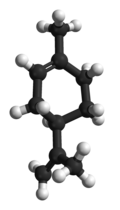D-limonene
|
|
|||
 |
|||
| Names | |||
|---|---|---|---|
|
IUPAC name
1-Methyl-4-(1-methylethenyl)-cyclohexene
|
|||
| Other names
4-Isopropenyl-1-methylcyclohexene
p-Menth-1,8-diene Racemic: DL-limonene; Dipentene |
|||
| Identifiers | |||
|
138-86-3 (R/S) 5989-27-5 (R) 5989-54-8 (S) |
|||
| 3D model (Jmol) | Interactive image | ||
| ChEBI |
CHEBI:15384 |
||
| ChEMBL |
ChEMBL449062 (R) |
||
| ChemSpider |
20939 (R/S) 388386 (S) 389747 (R) |
||
| ECHA InfoCard | 100.025.284 | ||
| KEGG |
D00194 |
||
| PubChem |
22311 (R/S) 439250 (S) |
||
| UNII |
9MC3I34447 (R/S) GFD7C86Q1W (R) 47MAJ1Y2NE (S) |
||
|
|||
|
|||
| Properties | |||
| C10H16 | |||
| Molar mass | 136.24 g·mol−1 | ||
| Appearance | colorless to pale-yellow liquid | ||
| Odor | Orange | ||
| Density | 0.8411 g/cm3 | ||
| Melting point | −74.35 °C (−101.83 °F; 198.80 K) | ||
| Boiling point | 176 °C (349 °F; 449 K) | ||
| insoluble | |||
| Solubility | miscible in alcohol, benzene, chloroform, ether, CS2, and oils soluble in CCl4 |
||
|
Chiral rotation ([α]D)
|
87° - 102° | ||
|
Refractive index (nD)
|
1.4727 | ||
| Thermochemistry | |||
|
Std enthalpy of
combustion (ΔcH |
−6.128 MJ mol−1 | ||
| Hazards | |||
| R-phrases | R10 R38 R43 R50/53 | ||
| S-phrases | (S2) S24 S37 S60 S61 | ||
| NFPA 704 | |||
| Flash point | 50 °C (122 °F; 323 K) | ||
| 237 °C (459 °F; 510 K) | |||
|
Except where otherwise noted, data are given for materials in their standard state (at 25 °C [77 °F], 100 kPa).
|
|||
|
|
|||
| Infobox references | |||
Limonene is a colorless liquid hydrocarbon classified as a cyclic terpene. The more common d-isomer possesses a strong smell of oranges. It is used in chemical synthesis as a precursor to carvone and as a renewables-based solvent in cleaning products. The less common l-isomer is found in mint oils and has a piney, turpentine-like odor.
Limonene takes its name from the lemon, as the rind of the lemon, like other citrus fruits, contains considerable amounts of this compound, which contributes to their odor. Limonene is a chiral molecule, and biological sources produce one enantiomer: the principal industrial source, citrus fruit, contains d-limonene ((+)-limonene), which is the (R)-enantiomer. Racemic limonene is known as dipentene. d-Limonene is obtained commercially from citrus fruits through two primary methods: centrifugal separation or steam distillation.
Limonene is a relatively stable terpene and can be distilled without decomposition, although at elevated temperatures it cracks to form isoprene. It oxidizes easily in moist air to produce carveol, carvone, and limonene oxide. With sulfur, it undergoes dehydrogenation to p-cymene.
Limonene occurs commonly as the d or (R)-enantiomer, but racemizes to dipentene at 300 °C. When warmed with mineral acid, limonene isomerizes to the conjugated diene α-terpinene (which can also easily be converted to p-cymene). Evidence for this isomerization includes the formation of Diels-Alder adducts between α-terpinene adducts and maleic anhydride.
...
Wikipedia



